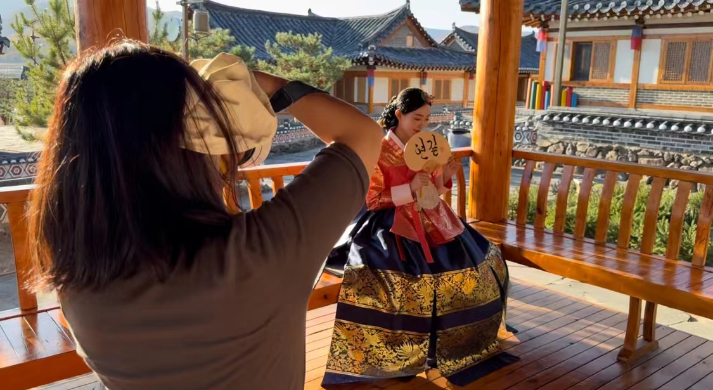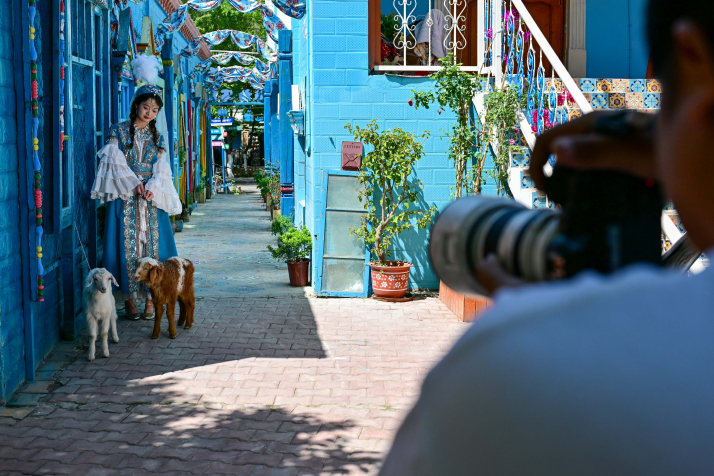| Lifestyle |
| Dressed to impress | |
|
|
 Piao Hua, a local photographer in Yanji, Jilin Province in northeast China, takes photos of her client dressed in the traditional local Korean ethnic costume in a nearby old Korean village on May 1 (COURTESY PHOTO)
From April 26 to May 6, Xu Jingyi took a trip she'd been planning for a whole year—alone, she traversed several regions across south China, including Sichuan and Yunnan provinces and Guangxi Zhuang Autonomous Region, where she took in the splendid scenery and rich ethnic folklore. "I dressed up in the traditional costumes of the Tibetan, Miao, Yi, Dai and Va ethnic groups, and had my pictures taken," Xu told Beijing Review. Many Chinese travelers in recent years have developed a taste for what are referred to as "ethnic travel shoots," which see tourists dressed to impress in traditional local clothing hamming it up for the camera all over the country. "I'm Han, but I am a big fan of different ethnic groups in China, and excited to learn about their cultures," Xu added. Out of China's 56 ethnicities, the Han are the majority ethnic group, making up 91.1 percent of the mainland's population, according to the seventh population census conducted in 2020. Xu is a fervent hanfu aficionada and model, with hanfu being the traditional dress of the Han Chinese. But in recent years, she has noticed that many people in her social circle, especially young women, who have participated in the revival of hanfu, are also promoting different Chinese ethnic cultures. "Ethnic travel shoots are part of that," she added. Influencers and models aside, "regular" visitors are also contributing to this trend. On Xiaohongshu, one of China's most popular lifestyle and e-commerce apps, tons of travelers are posting photos of themselves dressed to the nines in ethnic costumes, instead of more usual pictures of sceneries or activities. For example, "a one-day experience in Yanji as a Korean princess" is one of the hottest hashtags, raking in millions of views. Yanji is capital of Yanbian, the country's only autonomous prefecture of the Korean ethnic group in the northeastern province of Jilin, with the ethnic group accounting for more than half of its population. The small city is roughly 10 km from China's border with the Democratic People's Republic of Korea. Immerse yourself Xu made her recent trip to enrich her overall travel experience. "When I was a child, my parents could only afford large group travel," she recalled. "We used to get up early, squeeze into buses and visit numerous attractions in one day without ever really 'digging into' any places. When we'd get back home, I could usually only remember being tired." "This partially explains the popularity of today's ethnic travel shoots because they allow you to wholly immerse yourself in a place," Xu elaborated. Moreover, she wants her parents to have a similar opportunity. "I want my parents to have this precious, personalized experience. I'm saving up to take them to Yanji to do a Korean ethnic travel shoot this summer," she added. In recent years, Yanbian has become a top destination for domestic travel. Korean clothing was listed as national intangible cultural heritage in China in 2008, and Korean ethnic travel shoots are on the to-do list of many a visitor to the area. Piao Hua, a photographer from the Korean ethnic group in Yanji, has witnessed the momentum of these shoots in the past two years. "I have taken photos for over 1,000 visitors over the past two years and during peak season and public holidays, such as the May Day holiday (from May 1-5 this year), my studio is fully booked—well in advance, even. I often have 15 customers a day," Piao told Beijing Review. Piao has also observed that visitors are starting to prefer to conduct the shoots in more meaningful settings. "People rent traditional Korean costumes and want to have their photos taken in, for example, the old Korean villages located farther away from the city center," she elaborated. "So aside from doing a shoot inside the studio, we also offer these and more related services; I believe this is the future trend of this industry."  A visitor dressed in a modified version of the Kazakh ethnic costume, poses for her travel shoot in Yining, Ili Kazakh Autonomous Prefecture, Xinjiang Uygur Autonomous Region, on May 10 (XINHUA)
Cultural heritage The flourishing of ethnic travel shoots benefits local economies and provides ample associated job positions for residents from different ethnic groups. Between late 2022 and March this year, 191 newly registered travel photography stores had popped up in Yanji, according to Ecns.cn, a Beijing-based news portal. As of May, the city has 614 registered travel photography businesses. Piao is both excited about the orders flowing in and how the industry promotes her ethnic group's culture. "I'm proud of our unique culture. I'm so glad to see so many visitors curious about the history of our Korean village and fascinated by our local customs," Piao continued, adding that she usually shares some local cultural facts with her customers while taking photos. "For example, I will tell them how to strike traditional Korean poses and what their connotations are." The rich ethnic travel shoot products not only meet the personalized needs of tourists, but also offer up a whole new tourism category and development opportunities for places packing strong ethnic heritage. According to online travel agency Trip.com Group, as of late February, the number of travel shoot orders had seen a year-on-year increase of 63 percent. The number of travel shoot products and related businesses had increased by more than 30 percent. "Whether the destination abounds with entertainment products or not has become an essential factor for visitors when making travel plans," Dai Bin, head of China Tourism Academy, told Eeo.com.cn, a Chinese business news portal. "Yanji, with its Korean ethnic travel shoots, is a case in point. Travelers today like to have 'a sense of ritual' [yishigan in Chinese]. They want to wear the costumes, experience them. They find this soothing," Dai said. Yishigan is something many Chinese pursue in their personal relationships, e.g., giving someone flowers or a present whenever a special occasion arises. This concept now also extends to tourism, conveying how travelers want to slow down on their trips and really take in all their destination has to offer—instead of racing from one stop to the next. Governments are stepping up efforts to further embrace this emerging tourism trend to facilitate the development of the tourism industry at large. Harbin, capital of the northeastern province of Heilongjiang, was China's "hottest" snow and ice tourism destination this past winter. It recently released a list of recommended places and attractions to do shoots inspired by the local Russian ethnic group, including the city's typical seasonal attractions, such as ice lantern parks and the Snow and Ice World Park. Several new ethnic-travel-shoot bases that allow for all-year-round activities are also under construction. Copyedited by Elsbeth van Paridon Comments to zhangyage@cicgamericas.com |
|
||||||||||||||||||||||||||||
|